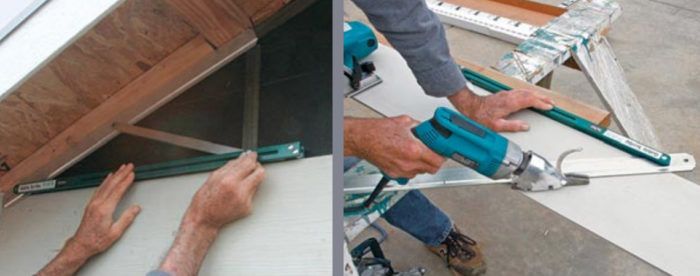Tools for Installing Fiber-Cement Siding
The popularity of this durable, low-maintenance siding has bred a variety of tools to simplify and speed installation.

Magazine extra: Specially made circular-saw blades are best for making straight cuts in fiber cement. But what do you use for non-straight cuts? Watch a series of videos where Mike Guertin demonstrates how to cut fiber cement siding using a circular saw, a variety of hand and small power tools, and shears.
Engineered building materials like I-joists, LVLs (laminated-veneer lumber), OSB (oriented strand board), and fiber-cement siding have become common ingredients in many of the houses we build nowadays. At times, though, I forget that engineered products are not new. Building materials like plywood and fiber-cement siding have been around longer than I have, if you can believe that. In fact, many of the houses built in the 1950s and ’60s still have their original, old-style fiber-cement siding. This material stopped being manufactured when one of its ingredients— asbestos—was discovered to be a major health hazard. Over the years, though, the old-growth pine, fir, and redwood trees that provided builders with unlimited, inexpensive siding materials were sufficiently depleted to open the market for a new version of fiber-cement siding.
This latest product is still made from cement, but the main additives are now cellulose fibers, silica sand, and water. After these ingredients are combined and mixed into a slurry, they are formed into siding, dried, and cured using pressurized superheated steam.
The final product is cheaper and more stable than most wood siding available today, and this stability means that it won’t warp, curl, rot, or split once it’s installed. Fiber cement holds paint well, and it won’t catch fire or attract termites. In fact, most fiber-cement manufacturers offer a 50-year warranty for their product. Even woodpeckers leave for softer, tastier morsels.
Just as many options as you get with wood siding
Today, fiber-cement siding comes in all the shapes and sizes that you would commonly find in wood-siding products. Clapboard-style fiber-cement siding is the most popular, and you can buy this material with a smooth or wood-grain finish, and with or without decorative grooves and beads. Clapboard planks are available in widths ranging from 5-1 ⁄4 in. to 12 in., and they are from 5/16 in. to 5/8 in. thick. A 1/2-in.-thick by 8-1 4-in.-wide by 12-ft.-long plank sells for about $8 at my local supply house here in Coos Bay, Ore.
If clapboards aren’t your fancy, fiber cement is also available in shingle form, with your choice of half-round, octagonal, or the standard square shapes. You also can purchase fiber-cement panels that are 4 ft. wide and 8 ft., 9 ft., or 10 ft. long. These sheets come with smooth, stucco, or wood-grain surface treatments and can be ordered with vertical grooves. Soffit material that is 12 in., 16 in., or 24 in. wide with vent holes is also on the market. Fiber-cement trim boards for windows, doors, and corners complete the exterior package.
One of the biggest labor-savers with this siding is that it comes primed and ready for a finish coat of paint. Some manufacturers have even gone a step farther and offer painted fiber-cement siding products in about 20 different colors, with a 10- to 15-year warranty on the finish. Color-matched touch-up kits conceal nicks or scratches that can occur during installation.
For more photos and information about proper layout and tools, click the View PDF button below.





